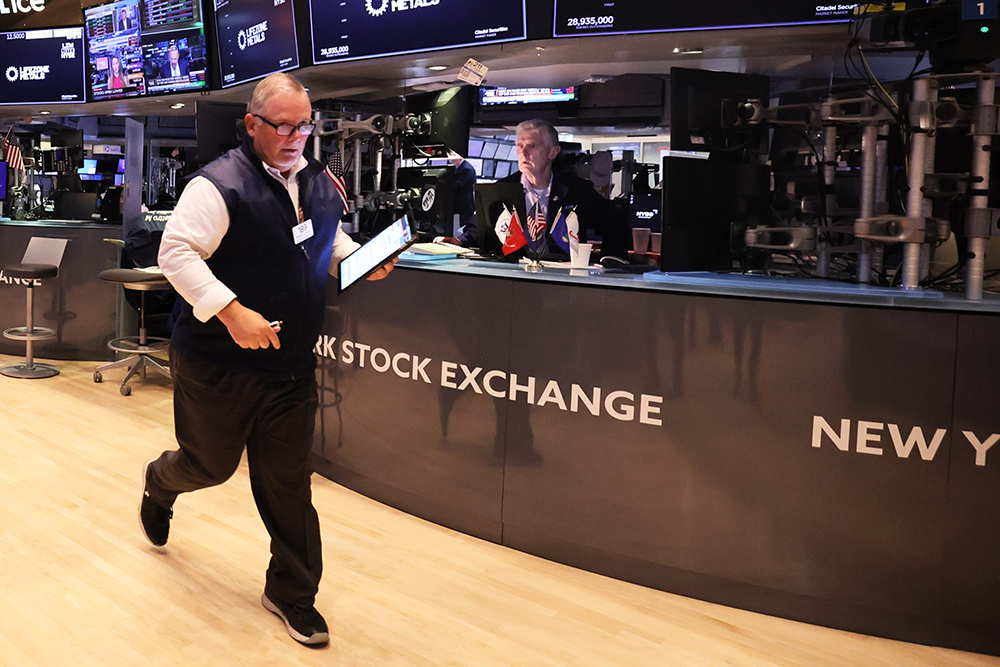
去年12月,所有讨论都认为2023年将是“债券年”。在去年冬天的一两个瞬间,这一呼声(以及支撑它的经济前景黯淡的预测)似乎是正确的。
然而,如今这些声音已经被湮没,因为股票需求激增推动全球股市剧烈反弹,加上有迹象表明这种涨势可能远未结束,使得投资者对股票优于债券的乐观程度比自24年前SentimentTrader模型开始对股票和债券进行比较以来的任何时候都高。
波士顿宏利资产管理公司(Manulife Asset Management)的全球资产配置主管内森·索夫特(Nathan Thooft)减少了信贷敞口,转而增持股票,称“随着市场悲观情绪、技术面不利因素和经济衰退风险进一步淡化,我们从减持股票转为增持股票”。
2023年具备固定收益实现突破的所有条件。美联储(Federal Reserve)结束了大举加息并转向宽松政策,这本应该会带动债券上涨,使其成为抵御经济增长下滑的保障措施。
结果经济似乎完成了一项罕见的壮举:通胀有所缓解,同时就业实现增长。经济增速不断加快,以致连美国央行的员工都不再预测经济将会衰退。目前美联储仍在加息,而债券并未发挥其作为安全阀的作用。
这一意外的逆转发生后,一些著名的卖方分析师发布道歉声明,其他人上调了他们的股票目标价,更多的人则是下调了经济衰退概率的预测或者完全放弃这种预测。
前一周,摩根大通(JPMorgan Chase & Co.)对客户进行了调查,其中超过一半的人表示他们现在相信,尽管美国正在快速加息,美国经济仍会继续扩张,即可能出现所谓的“软着陆”或“不着陆”。该调查显示,计划减持债券以增加股票敞口的投资者数量大幅增加。
这种情况已经发生。据德意志银行(Deutsche Bank AG)报告,根据自身对经济的看法来配置资金的全权投资者加快了股票的购买速度,与2020年底疫苗发布时的速度相当。过去3个月,从流入交易所交易基金的资金看,相比固定收益类证券,投资者强烈偏好股票,而这与今年年初的情况截然相反。
马奥尼资产管理公司(Mahoney Asset Management)的首席执行官肯•马奥尼(Ken Mahoney)表示:“这一年来,看跌的声音响彻至今,而市场全程都在攀登忧虑之墙。我们完全可以理解他们的看法,但他们忽略了显示股市正在走高的技术面。”
这并不是说债券今年会跑赢股票的预测完全错误。从整体上看,债券带来了正回报,而且投资者能够以承担低风险来获得高收益。只是今年股市出现了以往难以想象的涨幅——以科技股为主的纳斯达克100指数(NASDAQ 100)上涨了44%——这使它们的相对表现显得尤为优异,令华尔街专业人士都出乎意料。
尽管目前软着陆预期主导市场情绪,但这绝不是确定的。
贝莱德投资研究所(BlackRock Investment Institute)副主管亚历克斯•布雷热(Alex Brazier)在接受彭博电视台(Bloomberg TV)采访时表示:“目前市场预期经济将实现软着陆——必须采取许多举措才能达成这一目标,而且所有风险都朝着同一个方向。”
美联储加息525个基点的滞后效应可能在两年或更久之后才会波及整个经济。反通货膨胀的趋势可能只是油价大幅下跌引起的暂时现象。标准普尔500指数(S&P 500)中的科技股当前市盈率为28倍,这或许意味着抛售时机已经成熟,而仓位却偏向上行,任何减持都可能导致更大的损失。
不过,布雷热承认,今年到目前为止的情况并不像他和他在贝莱德的同事们预测的那样。
他说:“市场(尤其是美国股市)上发生的一切让许多人感到意外。”
SentimenTrader认为,这种转变可能会持续下去。不同于过去,现在公司内部人员是大买家,而波动性减弱和看涨期权等技术面正在推动股市情绪持续高涨。
Sundial Capital Research和SentimenTrader分析了期货仓位、调查结果、期权活动以及资金流动,其研究主任贾森•格普费特(Jason Goepfert)称,另外两次股市情绪与债市情绪差异如此之大的情形还要追溯到2003年和2009年,“那两次都发生在旷日持久的熊市之后,并且表明投资者预期发生了巨大的转变。两次都紧随着新一轮的牛市。”(财富中文网)
——本文由科林•基廷(Colin Keatinge)、锡德•维尔马(Sid Verma)和戴维•帕帕佐普洛斯(David Papadopoulos)协助撰写。
译者:中慧言-刘嘉欢
去年12月,所有讨论都认为2023年将是“债券年”。在去年冬天的一两个瞬间,这一呼声(以及支撑它的经济前景黯淡的预测)似乎是正确的。
然而,如今这些声音已经被湮没,因为股票需求激增推动全球股市剧烈反弹,加上有迹象表明这种涨势可能远未结束,使得投资者对股票优于债券的乐观程度比自24年前SentimentTrader模型开始对股票和债券进行比较以来的任何时候都高。
波士顿宏利资产管理公司(Manulife Asset Management)的全球资产配置主管内森·索夫特(Nathan Thooft)减少了信贷敞口,转而增持股票,称“随着市场悲观情绪、技术面不利因素和经济衰退风险进一步淡化,我们从减持股票转为增持股票”。
2023年具备固定收益实现突破的所有条件。美联储(Federal Reserve)结束了大举加息并转向宽松政策,这本应该会带动债券上涨,使其成为抵御经济增长下滑的保障措施。
结果经济似乎完成了一项罕见的壮举:通胀有所缓解,同时就业实现增长。经济增速不断加快,以致连美国央行的员工都不再预测经济将会衰退。目前美联储仍在加息,而债券并未发挥其作为安全阀的作用。
这一意外的逆转发生后,一些著名的卖方分析师发布道歉声明,其他人上调了他们的股票目标价,更多的人则是下调了经济衰退概率的预测或者完全放弃这种预测。
前一周,摩根大通(JPMorgan Chase & Co.)对客户进行了调查,其中超过一半的人表示他们现在相信,尽管美国正在快速加息,美国经济仍会继续扩张,即可能出现所谓的“软着陆”或“不着陆”。该调查显示,计划减持债券以增加股票敞口的投资者数量大幅增加。
这种情况已经发生。据德意志银行(Deutsche Bank AG)报告,根据自身对经济的看法来配置资金的全权投资者加快了股票的购买速度,与2020年底疫苗发布时的速度相当。过去3个月,从流入交易所交易基金的资金看,相比固定收益类证券,投资者强烈偏好股票,而这与今年年初的情况截然相反。
马奥尼资产管理公司(Mahoney Asset Management)的首席执行官肯•马奥尼(Ken Mahoney)表示:“这一年来,看跌的声音响彻至今,而市场全程都在攀登忧虑之墙。我们完全可以理解他们的看法,但他们忽略了显示股市正在走高的技术面。”
这并不是说债券今年会跑赢股票的预测完全错误。从整体上看,债券带来了正回报,而且投资者能够以承担低风险来获得高收益。只是今年股市出现了以往难以想象的涨幅——以科技股为主的纳斯达克100指数(NASDAQ 100)上涨了44%——这使它们的相对表现显得尤为优异,令华尔街专业人士都出乎意料。
尽管目前软着陆预期主导市场情绪,但这绝不是确定的。
贝莱德投资研究所(BlackRock Investment Institute)副主管亚历克斯•布雷热(Alex Brazier)在接受彭博电视台(Bloomberg TV)采访时表示:“目前市场预期经济将实现软着陆——必须采取许多举措才能达成这一目标,而且所有风险都朝着同一个方向。”
美联储加息525个基点的滞后效应可能在两年或更久之后才会波及整个经济。反通货膨胀的趋势可能只是油价大幅下跌引起的暂时现象。标准普尔500指数(S&P 500)中的科技股当前市盈率为28倍,这或许意味着抛售时机已经成熟,而仓位却偏向上行,任何减持都可能导致更大的损失。
不过,布雷热承认,今年到目前为止的情况并不像他和他在贝莱德的同事们预测的那样。
他说:“市场(尤其是美国股市)上发生的一切让许多人感到意外。”
SentimenTrader认为,这种转变可能会持续下去。不同于过去,现在公司内部人员是大买家,而波动性减弱和看涨期权等技术面正在推动股市情绪持续高涨。
Sundial Capital Research和SentimenTrader分析了期货仓位、调查结果、期权活动以及资金流动,其研究主任贾森•格普费特(Jason Goepfert)称,另外两次股市情绪与债市情绪差异如此之大的情形还要追溯到2003年和2009年,“那两次都发生在旷日持久的熊市之后,并且表明投资者预期发生了巨大的转变。两次都紧随着新一轮的牛市。”(财富中文网)
——本文由科林•基廷(Colin Keatinge)、锡德•维尔马(Sid Verma)和戴维•帕帕佐普洛斯(David Papadopoulos)协助撰写。
译者:中慧言-刘嘉欢
All the chatter back in December was that 2023 was to be the “year of the bond.” And for a brief moment or two in the winter, that call — and the economic doom-and-gloom that underpinned it — looked right.
It is now being overrun, though, by an avalanche of demand for equities that has unleashed a furious rally across the globe and, in a sign the gains are likely far from over, made investors more optimistic about stocks relative to bonds than at any point since SentimenTrader models began comparing them 24 years ago.
“As sentiment, technicals and risk of the recession got pushed further out we moved from being underweight stocks to overweight,” said Nathan Thooft, global head of asset allocation at Manulife Asset Management in Boston, who’s reduced his credit exposure in favor of an equity overweight.
2023 had all the makings of a breakout year for fixed income. The end of aggressive Federal Reserve rate hikes and a pivot to easier policy should have set up a rally in bonds and made them an insurance policy against a growth downturn.
Instead, the economy seems to have pulled off a rare feat: inflation has slowed while new jobs are being created. Growth keeps accelerating and even staff at the US central bank are no longer forecasting a recession. The Fed is still raising rates — though it may have just completed its last increase this week — and bonds aren’t living up their billing as a safety valve.
The surprising reversal has found some prominent sell-side strategists issuing mea culpas, others upgrading their stock targets, and more downgrading their recession forecasts or giving them up altogether.
More than half of clients surveyed last week by JPMorgan Chase & Co. say they are now convinced the US economy can continue to expand despite rapid-fire hikes, so-called “soft” or “no landing” scenarios. The survey shows a jump in the number of investors planning to boost equity exposure at the expense of bonds.
That’s already happening. Discretionary investors — who allocate cash based on their view of the economy — have ramped up their pace of stocks buying on par with the time of the vaccine announcement in late 2020, according to Deutsche Bank AG. Flows into exchange-traded funds show a strong preference for equities over fixed income in the last three months, a big reversal from the start of the year.
“The bears were loud all year and still are and meanwhile the market climbed the wall of worry perfectly the entire time,” said Ken Mahoney, chief executive officer of Mahoney Asset Management. “We definitely can understand their point of view. But they are missing out on the technicals that have been telling us stocks are working their way higher.”
It’s not like predictions that bonds would win this year have been entirely wrong — across the curve they’ve posted positive returns and investors are collecting big yields for little risk. It’s just that equities have posted once-unimaginable gains this year — the tech-heavy Nasdaq 100 is up 44% — that’s juiced their relative performance in ways that have blindsided Wall Street pros.
And while the soft-landing scenario is now the market’s favorite, it’s by no means certain.
“What the market’s now pricing is a soft landing — a lot has to go right for that, and the risks are in one direction,” Alex Brazier, deputy head of BlackRock Investment Institute, said in an interview with Bloomberg TV.
The lagged effect of 525 basis points of Fed rate hikes could take two years or more to ripple through the economy. The disinflation trend might be a blip that owes too much to falling oil prices. Tech stocks in the S&P 500 trading at 28 times prospective earnings may mean they are ripe for a selloff while positioning is so skewed to the upside, any pullback risks a bigger fall.
Still, Brazier admitted this year so far isn’t turning out like he and his BlackRock colleagues anticipated.
“What’s happened, particularly in the US stock market, has taken a lot of people by surprise,” he said.
SentimenTrader suggests the shift may endure. Unlike in the past, corporate insiders are big buyers, while technicals like subdued volatility and bullish options are keeping equity sentiment elevated.
The only other two instances when stocks versus bond sentiment were so wide apart were in 2003 and 2009 “both coming out of protracted bear markets and indicating a dramatic shift in investor expectations,” said Jason Goepfert, director of research at Sundial Capital Research and SentimenTrader, which analyzes futures positioning, surveys, options activity and fund flows. “Both preceded new bull markets.”
–With assistance from Colin Keatinge, Sid Verma and David Papadopoulos.






